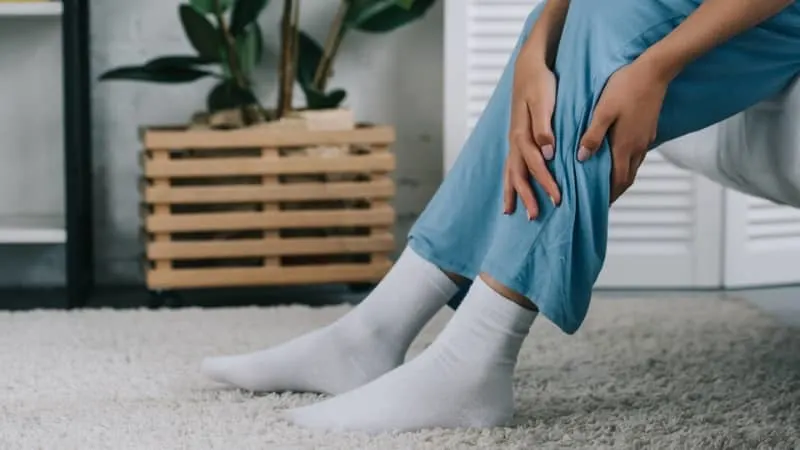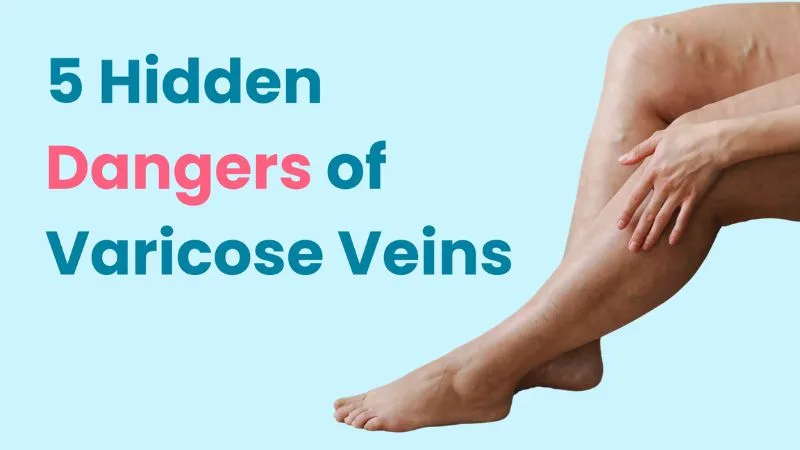Venous insufficiency is the medical term for vein disease. Venous insufficiency can lead to many outcomes. One of the most common is varicose veins.
Varicose veins are bulging veins, usually blue or purple in appearance, caused by poorly functioning veins.
The valves, or vein walls, have lost their elasticity(1). These veins then struggle to pump blood back to your heart, causing reflux, or pooling of blood in the legs.
Over 20% of the global adult population will get varicose veins in their lifetime(1), and women are more prone to varicose veins than men. About 22 million women and 11 million men between 40 and 80 years old live with varicose veins(2).
For some people, varicose veins are an unsightly nuisance. But for others, they cause leg cramping, aching, or heavy or tired legs.
But while those symptoms could simply be an annoyance, they could mean something more. This might be your body’s way of saying, “Watch out — danger ahead!”
Here are a few things your varicose veins may be warning you of:
Table of Contents
ToggleHidden Dangers of Varicose Veins
Varicose veins, if left untreated, can be a sign of worse to come. Here are five hidden dangers of varicose veins:

Edema
Edema, or leg swelling, may occur in patients with varicose veins due to the pressure that builds within the veins. Fluid from the blood can leak into the surrounding tissue, causing swelling.
Your skin itself may even leak the fluid, which can appear clear or yellowish. This can lead to changes in skin color and hardening of the skin.
In some cases, if the swelling is severe enough, you may even struggle to put your shoes on.
Varicose Eczema
Varicose eczema is a skin disorder that can occur in people who have varicose veins.
Stretched skin can become dry, cracked, shiny, and itchy. You might also experience purple or red sores and venous ulcers on the lower legs.
When skin stretches out from swelling, it becomes harder for the body to fight infection. Bacteria on the skin’s surface can then enter the body, causing a skin infection called cellulitis.
Cellulitis can cause fever, chills, nausea, vomiting, enlarging or hardening of the reddened area, increased pain, and numbness. Cellulitis can also spread to other areas of the body. In rare cases, individuals may even need surgery to remove the dead skin tissue.

Hemorrhage
People with varicose veins can have a significant amount of blood pooling below the skin’s surface. This means a cut or hit to the leg can cause a large amount of bleeding. In some cases, this bleeding may occur spontaneously: no cut or hit is needed.
Someone may first notice the problem when they feel blood running down their leg. As a result, they may start feeling faint. It may take longer than usual for bleeding to stop if the injury is extensive, which can even be life-threatening.
Older patients may be at a higher risk of spontaneous bleeding due to thin-walled veins(3). Such was the case of a 66-year-old woman found dead in her home, surrounded by a large quantity of blood. The cause? Massive bleeding from ruptured varicosity(4).
Thrombophlebitis
Thrombophlebitis is inflammation of a vein caused by a blood clot. Thrombophlebitis usually occurs in the superficial veins, the veins closest to the skin. Symptoms may include swelling, limb pain or tenderness, skin redness, and difficulty walking.
Most cases of superficial thrombophlebitis can last anywhere from two to six weeks. When superficial thrombophlebitis stems from varicose veins, individuals can have recurring episodes.
In some cases, thrombophlebitis may lead to deep vein thrombosis (DVT). This happens when the clot in the superficial vein extends further up and meets the deep veins.

Pulmonary Embolism
According to a recent study of over 400,000 adults, varicose veins significantly increase the risk of deep vein thrombosis(5).
Deep vein thrombosis, or DVT, occurs when a blood clot forms in one or more deep veins in your body, typically in your legs. DVT may cause leg pain and swelling. However, it can also occur with no symptoms.
If the blood clot in your deep veins breaks away, it can travel to your lungs. This is known as pulmonary embolism.
How does this happen, and why is it deadly? Let’s explain how the body works:
Blood from your legs first travels up to your heart. The heart then pumps this blood into your lungs through the pulmonary arteries. Pulmonary arteries are blood vessels that carry blood from the right side of the heart to the lungs’ capillaries.
Your lungs then supply this blood with oxygen.
If a blood clot becomes clogged in one of these arteries, it can cause severe damage to your lungs and deprive your blood of oxygen.
This lack of oxygen then harms other organs in your body. And in the case of a significant blockage, pulmonary embolism can lead to death.

Treatment
Pain while walking, sitting, or standing may be signs of venous insufficiency. If you experience any of these symptoms, it could be a warning sign saying, “Danger ahead!”
Fortunately, venous insufficiency is treatable with a safe, minimally invasive treatment, often with zero downtime, and covered by insurance.
The first step is to receive an ultrasound by a vascular ultra-tech specifically trained to look for signs of venous reflux (that’s medical speak for veins that no longer circulate blood properly).
If reflux is present, a vein specialist can perform a treatment called radiofrequency ablation. This non-surgical treatment uses gentle heat to collapse the damaged vein. The collapsed vein is then reabsorbed by the body, and you are back to living pain-free.
Patients report minimal discomfort and can return to their daily activities the very same day.
Conclusion
If you want to eliminate your warning signs and improve your vein health, don’t wait any longer. Treat your varicose veins today – and avoid potentially harmful consequences tomorrow.
Elite Vein Clinic has successfully treated hundreds of happy individuals who no longer feel pain and discomfort in their legs. We offer minimally invasive vein treatments in Phoenix, Chandler, Gilbert, Mesa, Scottsdale, Tempe, and Peoria. Book your consultation today and take the first step toward healthier veins and a healthier you.
References
- Antani, M.R., Dattilo, J.B. (2020) Varicose Veins. StatPearls. Treasure Island (FL): StatPearls Publishing https://www.ncbi.nlm.nih.gov/books/NBK470194/
- Piazza, G. (2014). Varicose veins. Retrieved from https://www.ahajournals.org/doi/10.1161/CIRCULATIONAHA.113.008331#:~:text=Approximately%2023%25%20of%20US%20adults%20have%20varicose%20veins.&text=If%20spider%20telangiectasias%20and%20reticular,men%20and%2085%25%20of%20women.&text=Generally%20more%20common%20in%20women,of%2040%20to%2080%20years.
- Nicholls SC. Sequelae of untreated venous insufficiency. Seminars in interventional radiology. https://www.ncbi.nlm.nih.gov/pmc/articles/PMC3036289/#r22162-6. Published September 2005.
- Fragkouli, Kleio, et al. “Unusual death due to a bleeding from a varicose vein: a case report.” BMC Research Notes, vol. 5, no. 1, 2012.https://bmcresnotes.biomedcentral.com/articles/10.1186/1756-0500-5-488.
- Shyue-Luen Chang, M. (2018, February 27). Varicose veins and Incident venous Thromboembolism (VTE) or PERIPHERAL artery Disease (PAD). Retrieved May 10, 2021, from https://jamanetwork.com/journals/jama/article-abstract/2673551



